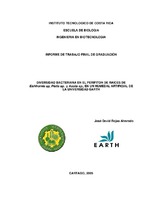| dc.contributor.author | Rojas-Alvarado, José David | es_CR |
| dc.date.accessioned | 2009-06-17T21:10:08Z | es_CR |
| dc.date.accessioned | 2011-11-25T22:27:48Z | |
| dc.date.available | 2009-06-17T21:10:08Z | es_CR |
| dc.date.available | 2011-11-25T22:27:48Z | |
| dc.date.issued | 2005 | es_CR |
| dc.identifier.uri | https://hdl.handle.net/2238/460 | es_CR |
| dc.description | Proyecto de Graduación (Bachillerato en Ingeniería en Biotecnología) Instituto Tecnológico de Costa Rica, Escuela de Biología, 2005. | es_CR |
| dc.description.abstract | Los procesos naturales de depuración de aguas residuales mediante humedales artificiales han sido tema de estudio desde hace ya varios años, muchos autores señalan que el proceso de tratamiento del agua esta influenciado por procesos biológicos, condicionados por variables físicas y químicas, desarrollados por la fauna y flora, donde la acción de los microorganismos que habitan en las raíces de las plantas acuáticas es fundamental ya que ayudan de manera no simbiótica a la degradación de la materia orgánica.
Por estas razones en el presente estudio, el objetivo principal es caracterizar e identificar algunos de los diferentes grupos bacterianos asociados a las raíces de tres especies de plantas acuáticas (Pistia sp, Eichhornia sp y Azolla sp) que habitan en el humedal artificial de la Finca Pecuaria Integrada de la Universidad EARTH, esto mediante el uso de medios de cultivo diferenciales y con la ayuda de métodos bioquímicos para posibilitar la identificación.
El humedal artificial está compuesto por cuatro lagunas y de cada una de ellas se tomaron dos especies de plantas acuáticas, con excepción de la laguna cuatro donde solamente se tomó una especie. Una vez obtenidas las raíces se les cultivó para un recuento estándar aeróbio mesofílico heterótrofo y se determinó la cantidad de UFC/g, también se cultivó la muestra en medios diferenciales con el fin de seleccionar colonias diferentes y obtener cultivos puros para su posterior identificación.
Se determinó que no hay una tendencia de aumento o de disminución de UFC/g, reflejandose que todas las lagunas experimentan cambios en su composición constantemente. Entre los géneros bacterianos identificados se encuentran: Acinetobacter sp, Aeromonas sp, Citrobacter sp, Chromobacterium sp, Enterobacter sp, Flavimonas sp, Klebsiella sp, Kluyvera sp, Pseudomonas sp, Morganella sp, Pantoea sp, Providencia sp, Serratia sp, Stenotrophomonas sp y Rahnella sp.
Algunos de estos se les atribuye alguna relación con la depuración natural de las aguas residuales especialmente en procesos desnitrificantes y eliminación de fosfatos, mientras que para otros grupos su importancia radica en que pueden ser cepas causantes de algunas infecciones en animales y el ser humano. | es_CR |
| dc.description.abstract | The natural purification process of residual water has been a topic in study many years ago. Many authors have indicated that the process of water treatment is influenced by biological processes, conditioned by physical and chemical variables, developed by flora and fauna of wetlands, where the action on microorganisms that inhabit the roots of the aquatic plants is fundamental since they help in a non symbiotic manner to the degradation of organic material. For these reasons, this study was conducted with the main objective of characterizing and identifying some of the different groups of bacteria associated with the roots of three aquatic plant species (Pistia sp, Eichhornia sp y Azolla sp) which inhabit the artificial wetland of the Integrated Cattle Farm of EARTH University, through the use of differential culture media and with the help of biochemical methods to facilitate the identification. The artificial wetland is made up of four lagoons where two aquatic plant species was collected with the exception of the fourth lagoon where only one specie was collected. Once the roots were obtained, a mesofilic aerobic heterotrophy standard counting was done and the quantity of UFC/g was determined. Also, the samples were cultured in different media with the aim of selecting different bacterial colonies and to obtain pure cultures for its identification. The results indicate no increase or decrease tendency of UFC/g. No data variations indicate that all the lagoons experience constant changes in their composition. Among the identified bacteria, the majority of the groups are Acinetobacter sp, Aeromonas sp, Citrobacter sp, Chromobacterium sp, Enterobacter sp, Flavimonas sp, Klebsiella sp, Kluyvera sp, Pseudomonas sp, Morganella sp, Pantoea sp, Providencia sp, Serratia sp, Stenotrophomonas sp and Rahnella sp. Most of these groups attribute a relationship with the natural purification of residual water specifically in the desnitrification processes and phosphate elimination while the other groups are important due to their being animal o human pathogens. | |
| dc.format.extent | 2819259 bytes | es_CR |
| dc.format.mimetype | application/pdf | es_CR |
| dc.language.iso | es | es_CR |
| dc.publisher | Instituto Tecnológico de Costa Rica. | es_CR |
| dc.rights | acceso abierto | es |
| dc.subject | Humedal artificial | es_CR |
| dc.subject | Bacterias | es_CR |
| dc.subject | Depuración | es_CR |
| dc.subject | Ecosistemas | es_CR |
| dc.subject | Pistia sp | es_CR |
| dc.subject | Azolla sp | es_CR |
| dc.subject | Eichhornia sp | es_CR |
| dc.subject | Raíces | es_CR |
| dc.subject | BIOT | es_CR |
| dc.title | Diversidad bacteriana en el perifiton de raices de eichhornia sp, pistia sp. y azolla sp., en un humedal artificial de la Universidad Earth. | es_CR |
| dc.type | proyecto fin de carrera | es |


